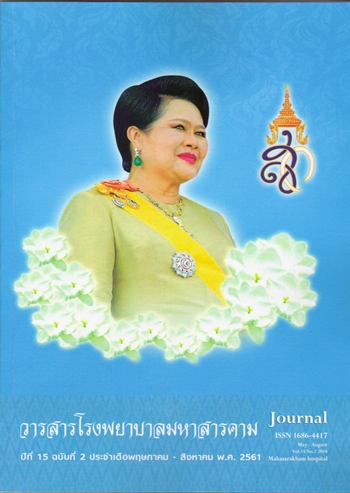ปัจจัยที่มีความสัมพันธ์กับอัตราการเสียชีวิตในช่วง 1 ปี ของผู้ป่วยกระดูกสะโพกหัก จากโรคกระดูกพรุน โรงพยาบาลเพชรบูรณ์
บทคัดย่อ
วัตถุประสงค์: เพื่อศึกษาอัตราการเสียชีวิตในช่วง 1 ปี และปัจจัยที่มีความสัมพันธ์กับการเสียชีวิตในช่วง 1 ปี ของผู้ป่วยกระดูกสะโพกหักจากโรคกระดูกพรุน
วิธีดำเนินการวิจัย : การศึกษาแบบมีกลุ่มควบคุม (case-control study)กลุ่มตัวอย่างเป็นผู้ป่วยกระดูกสะโพกหักที่เข้ารับการรักษาในโรงพยาบาลเพชรบูรณ์ ในเดือนตุลาคม 2556 -กันยายน 2559 จำนวน 476 คน เครื่องมือการวิจัยเป็นแบบบันทึกที่ผู้วิจัยสร้างขึ้น เก็บรวบรวมข้อมูลจากเวชระเบียนและสืบค้นข้อมูลการเสียชีวิตจากระบบทะเบียนราษฎร์ สำนักบริหารการทะเบียนกรมการปกครอง วิเคราะห์ข้อมูลด้วยสถิติความถี่ ร้อยละ ค่าเฉลี่ย ส่วนเบี่ยงเบนมาตรฐาน การวิเคราะห์ตัวแปรเชิงเดี่ยว การทดสอบไคว์สแคว์ และการวิเคราะห์แบบพหุถดถอยโลจิสติก กำหนดระดับนัยสำคัญที่ 0.05
ผลการวิจัย: ผู้ป่วยเป็นเพศหญิงร้อยะละ 77.5 เพศชาย 22.5 ตามลำดับ อายุเฉลี่ย 77.1 ปี อัตราการเสียชีวิตในช่วง 1 ปี สูงถึงร้อยละ 26.7 ปัจจัยที่มีความสัมพันธ์ต่อการเสียชีวิตในช่วง 1 ปี อย่างมีนัยสำคัญทางสถิติ ได้แก่ อายุมากกว่า 84 ปี (ORadj=1.78, 95%CI=1.03-3.10, p=0.041) และภาวะโรคร่วมจากโรคตับแข็ง (ORadj=19.54, 95% CI= 2.03-188.21, p=0.010) นอกจากนี้ผู้ป่วยที่มีภาวะแทรกซ้อนที่เพิ่มโอกาสการเสียชีวิตในช่วง 1 ปี คือ ปอดติดเชื้อ (ORadj=11.07, 95%CI=3.62-33.86, p<0.001) และแผลกดทับ (ORadj=4.16, 95%CI=1.31-13.24, p=0.016) สำหรับปัจจัยที่ลดโอกาสการเสียชีวิตในช่วง 1 ปีอย่างมีนัยสำคัญทางสถิติ ได้แก่การรักษาด้วยการผ่าตัดร้อยละ 70 (ORadj=0.30, 95%CI= 0.17-0.51, p<0.001) และการรับประทานแคลเซียมร้อยละ 41 (ORadj=0.59, 95%CI=0.35-0.98, p=0.042)
สรุป: ผู้ป่วยกระดูกสะโพกหักจากภาวะกระดูกพรุนที่มีอายุมาก มีโรคร่วมจากโรคตับแข็งมีโอกาสสูงที่จะเสียชีวิตในช่วง 1 ปี การรักษาด้วยวิธีผ่าตัดในระยะเวลาที่รวดเร็ว การให้ผู้ป่วยรับประทานแคลเซียม และการป้องกันภาวะแทรกซ้อนของปอดติดเชื้อและแผลกดทับ จะช่วยลดโอกาสการเสียชีวิตในช่วง 1 ปีของผู้ป่วยกระดูกสะโพกหักจากโรคกระดูกพรุนได้
คำสำคัญ: อัตราการเสียชีวิตโรคกระดูกพรุน, กระดูกสะโพกหัก , โรคกระดูกพรุน
เอกสารอ้างอิง
Foundation. IO. Facts and Statistics2017.
Johnell O, Kanis JA. An estimate of the worldwide prevalence and disability associated with osteoporotic fractures. Osteoporosis international : a journal established as result of cooperation between the European Foundation for Osteoporosis and the National Osteoporosis Foundation of the USA. 2006;17(12):1726-33.
Melton LJ, 3rd. Epidemiology of hip fractures: implications of the exponential increase with age. Bone. 1996;18(3 Suppl):121s-5s.
Gullberg B, Johnell O, Kanis JA. World-wide projections for hip fracture. Osteoporosis international : a journal established as result of cooperation between the European Foundation for Osteoporosis and the National Osteoporosis Foundation of the USA. 1997;7(5):407-13.
Khosla S, Lufkin EG, Hodgson SF, Fitzpatrick LA, Melton LJ, 3rd. Epidemiology and clinical features of osteoporosis in young individuals. Bone. 1994;15(5):551-5.
Songpatanasilp T, Sritara C, Kittisomprayoonkul W, Chaiumnuay S, Nimitphong H, Charatcharoenwitthaya N, et al. Thai Osteoporosis Foundation (TOPF) position statements on management of osteoporosis. Osteoporosis and Sarcopenia. 2016;2(4):191-207.
Katsoulis M, Benetou V, Karapetyan T, Feskanich D, Grodstein F, Pettersson-Kymmer U, et al. Excess mortality after hip fracture in elderly persons from Europe and the USA: the CHANCES project. Journal of internal medicine. 2017;281(3):300-10.
Schnell S, Friedman SM, Mendelson DA, Bingham KW, Kates SL. The 1-Year Mortality of Patients Treated in a Hip Fracture Program for Elders. Geriatric Orthopaedic Surgery & Rehabilitation. 2010;1(1):6-14.
Ho CA, Li CY, Hsieh KS, Chen HF. Factors determining the 1-year survival after operated hip fracture: a hospital-based analysis. Journal of orthopaedic science : official journal of the Japanese Orthopaedic Association. 2010;15(1):30-7.
Tay E. Hip fractures in the elderly: operative versus nonoperative management. Singapore Medical Journal. 2016;57(4):178-81.
Amphansap T, Nitiwarangkul L. One-year mortality rate after osteoporotic hip fractures and associated risk factors in Police General Hospital. Osteoporosis and Sarcopenia. 2015;1(1):75-9.
Nurmi-Luthje I, Sund R, Juntunen M, Luthje P. Post-hip fracture use of prescribed calcium plus vitamin D or vitamin D supplements and antiosteoporotic drugs is associated with lower mortality: a nationwide study in Finland. Journal of bone and mineral research : the official journal of the American Society for Bone and Mineral Research. 2011;26(8):1845-53.
14.
at Chiang Mai University Hospital, Thailand, during 2006 and 2007. Journal of the Medical Association of Thailand = Chotmaihet thangphaet. 2015;98(1):59-64.
Farahmand BY, Michaëlsson K, Ahlbom A, Ljunghall S, Baron JA. Survival after hip fracture. Osteoporosis International. 2005;16(12):1583-90.
Karagiannis A, Papakitsou E, Dretakis K, Galanos A, Megas P, Lambiris E, et al. Mortality Rates of Patients with a Hip Fracture in a Southwestern District of Greece: Ten-Year Follow-Up with Reference to the Type of Fracture. Calcified Tissue International. 2006;78(2):72-7.
Tsuboi M, Hasegawa Y, Suzuki S, Wingstrand H, Thorngren K-G. Mortality and mobility after hip fracture in Japan. A TEN-YEAR FOLLOW-UP. 2007;89-B(4):461-6.
Kang HY, Yang KH, Kim YN, Moon SH, Choi WJ, Kang DR, et al. Incidence and mortality of hip fracture among the elderly population in South Korea: a population-based study using the national health insurance claims data. BMC public health. 2010;10:230.
Rosso F, Dettoni F, Bonasia DE, Olivero F, Mattei L, Bruzzone M, et al. Prognostic factors for mortality after hip fracture: Operation within 48 hours is mandatory. Injury. 2016;47(Supplement 4):S91-S7.
Moon Y-W, Kim Y-S, Kwon S-Y, Kim S-Y, Lim S-J, Park Y-S. Perioperative Risk of Hip Arthroplasty in Patients with Cirrhotic Liver Disease. Journal of Korean Medical Science. 2007;22(2):223-6.
Hsieh P-H, Ueng SW, Lee MS, Shih H-N, Huang K-C. Prosthetic hip infection in patients with liver cirrhosis: an outcome analysis. International Journal of Infectious Diseases. 2010;14(12):e1054-e9.
Rai SK, Varma R, Wani SS. Does time of surgery and complication have any correlation in the management of hip fracture in elderly and can early surgery affect the outcome? European journal of orthopaedic surgery & traumatology : orthopedie traumatologie. 2017.
Magaziner J, Hawkes W, Hebel JR, Zimmerman SI, Fox KM, Dolan M, et al. Recovery from hip fracture in eight areas of function. The journals of gerontology Series A, Biological sciences and medical sciences. 2000;55(9):M498-507.
Magny E, Vallet H, Cohen-Bittan J, Raux M, Meziere A, Verny M, et al. Pressure ulcers are associated with 6-month mortality in elderly patients with hip fracture managed in orthogeriatric care pathway. Archives of osteoporosis. 2017;12(1):77.
ดาวน์โหลด
เผยแพร่แล้ว
รูปแบบการอ้างอิง
ฉบับ
ประเภทบทความ
สัญญาอนุญาต
วารสารนี้เป็นลิขสิทธิ์ของโรงพยาบาลมหาสารคาม






